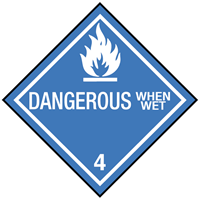
 Print
Print
Chemical Datasheet
ETHYL ALUMINUM SESQUICHLORIDE |


|
Chemical Identifiers
| CAS Number |
UN/NA Number |
DOT Hazard Label |
USCG CHRIS Code |
|
|
|
- Spontaneously Combustible
- Dangerous When Wet
|
|
| NIOSH Pocket Guide |
International Chem Safety Card |
|
none
|
none
|
NFPA 704
General Description
A clear yellow liquid. Slightly denser than water. Used to make other chemicals.
Hazards
Reactivity Alerts
- Strong Reducing Agent
- Water-Reactive
- Pyrophoric
Air & Water Reactions
Spontaneously flammable in air (Douda 1966). Reacts violently with water forming hydrogen chloride and flammable ethane gas (Rose 1961).
Fire Hazard
Special Hazards of Combustion Products: Intense smoke may cause metal-fume fever. Irritating hydrogen chloride also formed.
Behavior in Fire: Contact with water from adjacent fires will cause formation of irritating smoke containing aluminum oxide and hydrogen chloride. (USCG, 1999)
Health Hazard
Inhalation of smoke from fire causes metal-fume fever (flu-like symptoms); acid fumes irritate nose and throat. Contact with liquid, which is spontaneously flammable, causes severe burns of eyes and skin. (USCG, 1999)
Reactivity Profile
Organometallics, such as ETHYL ALUMINUM SESQUICHLORIDE, are reactive with many other groups. Incompatible with acids and bases. Organometallics are good reducing agents and therefore incompatible with oxidizing agents. Often reactive with water to generate toxic or flammable gases. Organometallics containing halogens (fluorine, chlorine, bromine, iodine) bonded to the metal typically with generate gaseous hydrohalic acids (HF, HCl, HBr, HI) with water. A mixture of this material with carbon tetrachloride exploded when warmed to room temperature [Bretherick, 5th Ed., 1995].
Belongs to the Following Reactive Group(s)
- Metal Hydrides, Metal Alkyls, Metal Aryls, and Silanes
Potentially Incompatible Absorbents
No information available.
Response Recommendations
Isolation and Evacuation
Excerpt from ERG Guide 135 [Substances - Spontaneously Combustible]:
IMMEDIATE PRECAUTIONARY MEASURE: Isolate spill or leak area in all directions for at least 50 meters (150 feet) for liquids and at least 25 meters (75 feet) for solids.
SPILL: Increase the immediate precautionary measure distance, in the downwind direction, as necessary.
FIRE: If tank, rail tank car or highway tank is involved in a fire, ISOLATE for 800 meters (1/2 mile) in all directions; also, consider initial evacuation for 800 meters (1/2 mile) in all directions. (ERG, 2024)
Firefighting
Excerpt from ERG Guide 135 [Substances - Spontaneously Combustible]:
DO NOT USE WATER, CO2 OR FOAM ON MATERIAL ITSELF. Some of these materials may react violently with water. CAUTION: For Xanthates, UN3342 and for Dithionite (Hydrosulfite/Hydrosulphite) UN1384, UN1923 and UN1929, USE FLOODING AMOUNTS OF WATER for SMALL AND LARGE fires to stop the reaction. Smothering will not work for these materials, they do not need air to burn.
SMALL FIRE: Dry chemical, soda ash, lime or DRY sand, EXCEPT for UN1384, UN1923, UN1929 and UN3342.
LARGE FIRE: DRY sand, dry chemical, soda ash or lime EXCEPT for UN1384, UN1923, UN1929 and UN3342, or withdraw from area and let fire burn. CAUTION: UN3342 when flooded with water will continue to evolve flammable Carbon disulfide/Carbon disulphide vapors. If it can be done safely, move undamaged containers away from the area around the fire.
FIRE INVOLVING TANKS, RAIL TANK CARS OR HIGHWAY TANKS: Fight fire from maximum distance or use unmanned master stream devices or monitor nozzles. Do not get water inside containers or in contact with substance. Cool containers with flooding quantities of water until well after fire is out. Withdraw immediately in case of rising sound from venting safety devices or discoloration of tank. ALWAYS stay away from tanks in direct contact with flames. (ERG, 2024)
Non-Fire Response
Excerpt from ERG Guide 135 [Substances - Spontaneously Combustible]:
ELIMINATE all ignition sources (no smoking, flares, sparks or flames) from immediate area. Do not touch or walk through spilled material. Stop leak if you can do it without risk.
SMALL SPILL: CAUTION: For spills of Xanthates, UN3342 and for Dithionite (Hydrosulfite/Hydrosulphite), UN1384, UN1923 and UN1929, dissolve in 5 parts water and collect for proper disposal. CAUTION: UN3342 when flooded with water will continue to evolve flammable Carbon disulfide/Carbon disulphide vapors. Cover with DRY earth, DRY sand or other non-combustible material followed with plastic sheet to minimize spreading or contact with rain. Use clean, non-sparking tools to collect material and place it into loosely covered plastic containers for later disposal. Prevent entry into waterways, sewers, basements or confined areas. (ERG, 2024)
Protective Clothing
Full protective clothing, preferably of aluminized glass cloth; goggles, face shield, gloves; in case of fire, all-purpose canister or self-contained breathing apparatus. (USCG, 1999)
DuPont Tychem® Suit Fabrics
No information available.
First Aid
INHALATION: only fumes from fire need be considered; metal-fume fever is not critical and lasts less than 36 hrs.; irritation of nose and throat by acid vapors may require treatment by a physician.
EYES: flush gently with water for 15 min.; treat burns if fire occurred; get medical attention.
SKIN: wash with water; treat burns caused by fire; get medical attention. (USCG, 1999)
Physical Properties
Flash Point: data unavailable
Lower Explosive Limit (LEL): data unavailable
Upper Explosive Limit (UEL): data unavailable
Autoignition Temperature: data unavailable
Melting Point:
-4°F
(USCG, 1999)
Vapor Pressure: data unavailable
Vapor Density (Relative to Air): data unavailable
Specific Gravity:
1.092
at 77°F
(USCG, 1999)
- Denser than water; will sink
Boiling Point:
399°F
at 760 mmHg
(USCG, 1999)
Molecular Weight:
247.5
(USCG, 1999)
Water Solubility: data unavailable
Ionization Energy/Potential: data unavailable
IDLH: data unavailable
AEGLs (Acute Exposure Guideline Levels)
No AEGL information available.
ERPGs (Emergency Response Planning Guidelines)
No ERPG information available.
PACs (Protective Action Criteria)
No PAC information available.
Regulatory Information
EPA Consolidated List of Lists
No regulatory information available.
CISA Chemical Facility Anti-Terrorism Standards (CFATS)
No regulatory information available.
OSHA Process Safety Management (PSM) Standard List
No regulatory information available.
Alternate Chemical Names
- ALUMINUM, TRICHLOROTRIETHYLDI-
- EASC
- ETHYL ALUMINUM SESQUICHLORIDE
- ETHYLALUMINUM SESQUICHLORIDE
- SESQUIETHYLALUMINUM CHLORIDE
- TRICHLOROTRIETHYLDIALUMINIUM
- TRICHLOROTRIETHYLDIALUMINUM
- TRIETHYLALUMINUM SESQUICHLORIDE
- TRIETHYLDIALUMINUM TRICHLORIDE
- TRIETHYLTRICHLORODIALUMINUM



 Print
Print

